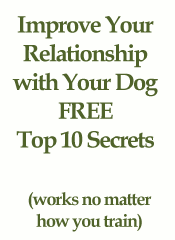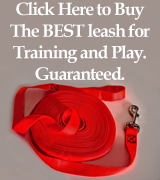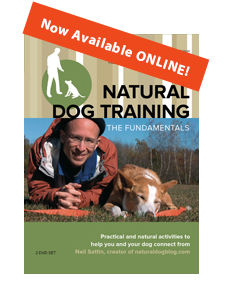Among the most popular articles on this site is the one I wrote about the best way to introduce two dogs to each other (in ten easy steps!) using Natural Dog Training techniques. One recent reader asked a question in the comments, and I thought I'd answer it here for everyone's benefit. This is also a chance for long-time readers (as will be most of these "questions answered" segments) to see how far you've come in your understanding of dogs via Natural Dog Training. Magie writes:
I had just read your article about introducing two new dogs to each other and I have a question. I have a 1 1/2 year old Rottweiler male and I rescued him from a local shelter. I would love to have him interact with other dogs but because of the breed I’m not sure if he would give a warning before he would attack. Therefore, I’m afraid to let him meet other dogs.
I went to the vet and there was a smaller dog there and he kept running towards him wanting to sniff. Of course i didnt allow cause the woman holding the little dog would have had a heart attack.
How do i solve this problem?
It sounds like there are a few problems going on here.
The first issue is: What are the warning signs of an aggressive dog - i.e. how do you know if your rottie is about to go ballistic?
The second is: How do you negotiate an encounter in close quarters - say, at the vet?
The third is: How do you get a feel for how your dog is going to act with other dogs?
First things first - your fear, let go of it you must
The only way that you are going to be in control in these situations (and the best way to help your dog) is if you can stay relaxed. Focus on your breathing, keeping it slow and steady. It will help keep your mind clear, so that you can have an accurate awareness of what's happening with your dog and the other dog.
Warning signs of an aggressive dog
Is your dog stiffening up? Are the ears back or raised? Is the tail wagging in quick little vibrations, back and forth? These are all signs of tension in your dog, and, if you remember from reading my article(s) on dog aggression, tension - in an energized moment - is what's at the heart of an overload behavior (like aggression). Now tension doesn't mean that your dog is going to be aggressive, necessarily (ultimately your dog might roll over and pee) - but it IS a warning sign for you, and it's an opportunity for you to be proactive, using a Natural Dog Training technique like pushing to help your dog release the tension. That's one of the reasons why I recommend introducing two dogs on a walk - to maximize the flow of emotional energy, and to minimize the stress of the face-to-face encounter. There are plenty of on-line resources that describe signs of an impending attack - lip raised, snarling, etc. You almost always feel the tension building and building in those moments, before a dog snaps.
So the point is that Natural Dog Training gives you an avenue for dealing with the tension before it escalates to aggression.
How do you negotiate interactions between dogs in close quarters, like the vet's office?
Your instinct was a good one, that you shouldn't let your dog just run up to another dog in the waiting room at the vet's office. It's always advisable to keep your dog close to you, on leash, and to use techniques like pushing (or obedience, like a down-stay) to keep your dog focused on you in the moment, instead of the other things that are there. If the waiting room is really crowded and you're worried about your ability to manage your dog, you might ask if you can wait outside, where there's much less intensity for your dog. It's not important for your dog to be friends with all the other patients at the vets office. And who knows, those other pets might have something contagious (and dogs are notoriously bad at covering their mouths when they sneeze)!
How do you get a feel for how your dog is going to act around other dogs?
The best way is for you to conduct controlled experiments with other dogs - say, your friends' dogs - outside. If you have friends with dogs that are known to be low-key and rock-solid around other dogs - start with them. Use the guidelines in my guide for introducing two dogs to each other, and let the dogs get to know each other over several different meetings before you attempt any off-leash interactions. And when you DO let your dog off-leash, let the dogs play for a little bit, but then separate them before things get too intense. At that point, play tug or do some pushing with your dog to help your dog release any stress stored from that encounter with the other dog. At all times you will be reinforcing for your dog that interacting with YOU is the way to handle excess energy and stress - which will give you a pathway to access your dog's awareness as the energy level of any situation escalates.
Some concluding thoughts on how to get a sense for how your dog is going to act around other dogs
In my opinion, there are many dogs these days that are over-socialized, and, for that matter, too many owners who are really worried that their dog isn't getting enough playtime with other dogs - especially if they have a dog that tends towards aggression. In the grand scheme of things, what's important for your dog is NOT that they have other dogs to play with. What IS important for your dog is that they have a chance to be a dog, to do what dogs do. And that is simply to have an outlet for their prey drive as way of handling the emotional energy (and stress) of their days in "human-world". The more that you can show your dog what to do with their energy, and the closer that you get to resolving 100% of your stored up stress, the happier your dog will be. And your dog will be guaranteed to be more social when around other beings - dogs, cats, people, etc.
One last thing: I was just featured in the Editor's blog over at the Vegetarian Times. She had some questions for me about how to handle the arrival of a new baby in a house with a dog, and wrote up a great summary of our conversation. I'll have to write up a more in-depth article on that topic for the natural dog blog, but, in the meantime - here's a link to the article at the Vegetarian Time. Enjoy!




